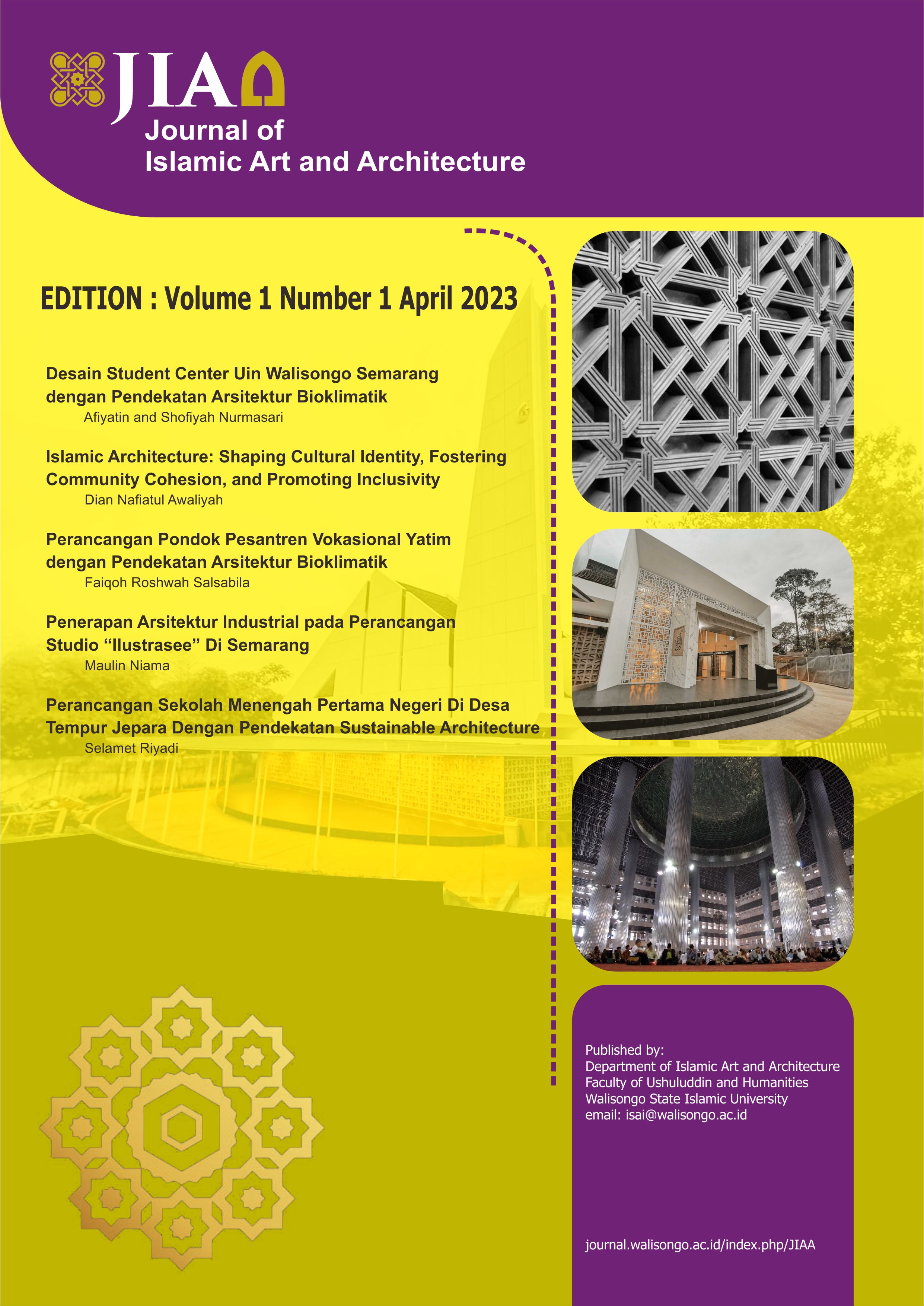DESAIN STUDENT CENTER UIN WALISONGO SEMARANG DENGAN PENDEKATAN ARSITEKTUR BIOKLIMATIK
Keywords:
Uin Walisongo, student center, bioklimatik, SemarangAbstract
Secara umum Desain Student Center UIN Walisongo Semarang dengan fokus pada konsep arsitektur bioklimatik. Latar belakang penelitian adalah tidak terpusatnya gedung PKM yakni pusat kegiatan mahasiswa yang ada serta penggunaan ruang yang tidak sesuai. Penelitian ini bertujuan untuk merencanakan dan merancang Student Center yang nyaman dan berkelanjutan sesuai dengan konsep arsitektur bioklimatik. Data diperoleh melalui studi literatur, studi kasus, dan wawancara. Hasil analisis menghasilkan konsep-konsep yang mencakup tema, bentuk, tapak, fungsi, ruang, dan utilitas. Student Center ini dirancang agar mendukung pembelajaran, pengembangan keterampilan, serta relaksasi mahasiswa dalam berbagai aktivitas perkuliahan baik akademik maupun non-akademik.
Downloads
References
Adi, A. R (2017). Kajian konsep ekologis pada gedung perpustakaan pusat UGM. Jurnal Atrium. Vol. 3, No. 1, Mei 2017, 69-83
Ali, M. M. (2008). Energy efficient architecture and building systems to address global warming. Leadership and Management in Engineering.
Astuti, Z B; Kusumawanto, A. 2014. Green Urban Waterfront Management Case of Solo, Indonesia. Journal Of Architecture & Environment 13.2: pp. 175-194.
Aulia, D. N. (2005). Permukiman yang berwawasan lingkungan. Jurnal Sistem Teknik Industri Volume 6, No. 4, 1-5.
Chan, A., & Chow, T. (2014). Calculation of overall thermal transfer value for commercial buildings constructed with naturally ventilated double skin Facade in subtropical Hong Kong. Energy and Buildings, 69, 14-21.
Frick, H. (1998). Dasar-dasar arsitektur ekologis. Yogyakarta: Kanisius.
Green Building Council Indonesia. (2013). Greenship untuk bangunan baru v1.2.
Haynes, R. 2010. Embodied Energy Calculations within Life Cycle Analysis of Residential Buildings
Loekita, S. (2006). Analisis konservasi energi melalui selubung bangunan. Dimensi Teknik Sipil, 8, 93-98.
Omer, A M. 2008. Energy, Environment and Sustainable Development. ELSEVIER Renewable and Sustainable Energy Reviews 12: pp. 2265–2300
Radhi, H. 2009. Evaluating The Potential Impact of Global Warming on The UAE Residential Buildings–A Contribution to Reduce The CO2 Emissions. ELSEVIER Building and Environment 44: pp. 2451–2462
Ryn, S. V., & Cowan, S. (2006). Ecological design redux. Buildings for the 21st Century, 14.
Titisari, E. Y., Triwinarto, J., & Suryasari, N. (2012). Konsep ekologis pada arsitektur di Desa Bendosari. Jurnal RUAS, Volume 10 N0 2, 1693-3702.
Verbeck, B. J., & Lakey, J. S. (1998). Ecological aesthetics, humane design. ASCE Engineering Approaches to Ecosystem Restoration, 1-6.
Widigdo C. W., & Canadarma, I. K. (2008). Pendekatan ekologi pada rancangan arsitektur sebagai upaya mengurangi pemanasan global. Prosiding Seminar Nasional Lingkungan Hidup.
Downloads
Published
Issue
Section
License
Copyright
The copyright of the received article shall be assigned to the journal as the publisher of the journal. The intended copyright includes the right to publish the article in various forms (including reprints). The journal maintains the publishing rights to the published articles. Therefore, the author must submit a statement of the Copyright Transfer Agreement.*)
Licensing

This work is licensed under a Creative Commons Attribution-ShareAlike 4.0 International License.
In line with the license, authors are allowed to share and adapt the material. In addition, the material must be given appropriate credit, provided with a link to the license, and indicated if changes were made. If authors remix, transform or build upon the material, authors must distribute their contributions under the same license as the original.
_______
*) Authors whose articles are accepted for publication will receive confirmation via email and send a Copyright Transfer Agreement.






